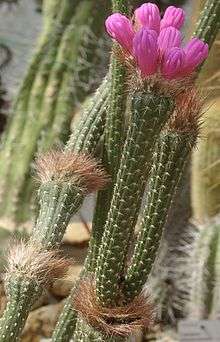Arrojadoa
| Arrojadoa | |
|---|---|
 | |
| Arrojadoa penicillata | |
| Scientific classification | |
| Kingdom: | Plantae |
| (unranked): | Angiosperms |
| (unranked): | Eudicots |
| (unranked): | Core eudicots |
| Order: | Caryophyllales |
| Family: | Cactaceae |
| Subfamily: | Cactoideae |
| Tribe: | Cereeae |
| Genus: | Arrojadoa Britton & Rose |
| Species | |
| |
| Synonyms | |
|
Pierrebraunia Esteves[1] | |
Arrojadoa is a genus of cacti, comprising 6 species and several varieties. It is named after the Brazilian Miguel Arrojado Lisboa. The genus occurs only in northern Brazil and is found at rocky places, under shrubs, which support their frail stalk. They are subtropical plants, with very little frost tolerance.
The species often have frail stalks that can be upright or procumbent, reaching 2 m high and about 2 to 5 cm thick. There are from 10 to 15 ribs, and ramifications are rare, and usually occur from the base.
The flowers are nocturnal and tube-like, measuring 1 to 3 cm in length and 0.5 to 1 cm in diameter. Flower colors can be pink or carmine. The fruit is berry-like, spherical with a maximal diameter of 1.5 cm, and pink or red when ripe.
Cultivation
The plant is easy to cultivate and flowers prolifically. It multiplies either by seed or by cuttings. It grows best on slightly humid soil and with plenty of watering from spring to autumn. In winter it should be left without water and at a minimal temperature of 10°C.
References
- ↑ Anderson 2001, p. 117
External links
Bibliography
- Anderson, Edward F. (2001), The Cactus Family, Pentland, Oregon: Timber Press, ISBN 978-0-88192-498-5